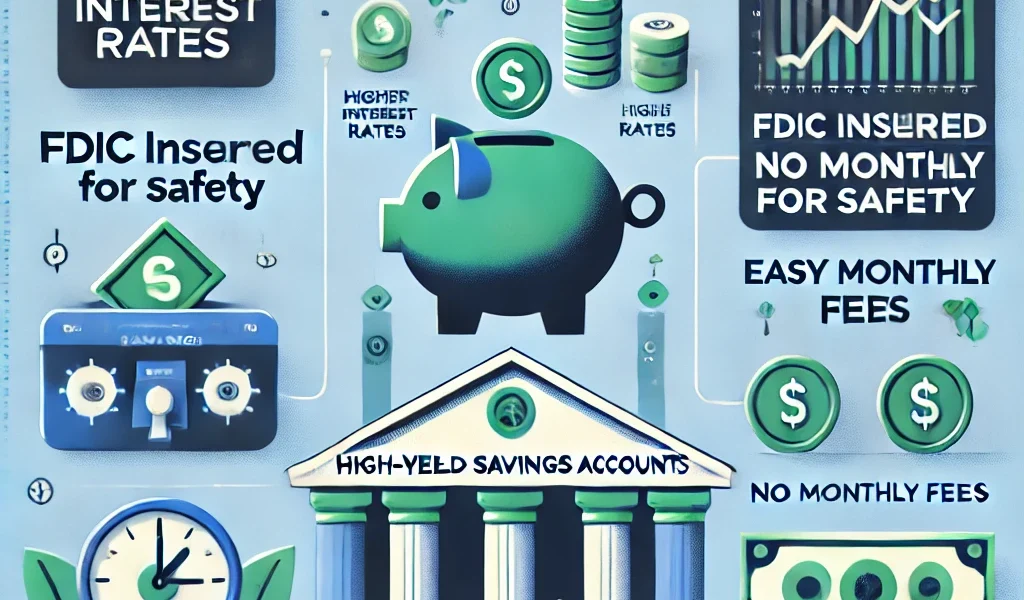Saving money is a fundamental part of financial planning, but simply stashing cash in a traditional savings account may not be the most effective way to grow your wealth. High-yield savings accounts (HYSA) offer significantly better interest rates than standard savings accounts, helping you maximize your interest earnings while keeping your funds secure and accessible.
In this guide, we’ll explore what high-yield savings accounts are, how they work, the best options available in 2025, and key factors to consider when choosing the right account for your financial goals.
What is a High-Yield Savings Account?
A high-yield savings account (HYSA) is a type of savings account that offers higher interest rates than traditional savings accounts. These accounts are typically offered by online banks, credit unions, and some traditional financial institutions, allowing savers to earn more on their deposits.
Key Features of High-Yield Savings Accounts:
- Higher Interest Rates: Typically 10-20 times higher than standard savings accounts.
- FDIC/NCUA Insurance: Ensures deposits are protected up to $250,000 per depositor.
- Easy Accessibility: Most accounts allow online and mobile banking with convenient fund transfers.
- Low Fees: Many HYSAs have no monthly fees or minimum balance requirements.
- Flexible Deposits & Withdrawals: Allows transfers, though some accounts may limit transactions per month.
Why Choose a High-Yield Savings Account?
1. Higher Interest Earnings
Traditional savings accounts offer an average 0.01% to 0.05% annual percentage yield (APY), whereas high-yield savings accounts can offer rates as high as 4.00% to 5.50% APY.
For example, if you deposit $10,000 in a regular savings account at 0.05% APY, you’d earn just $5 per year. But with a high-yield savings account at 4.50% APY, you could earn $450 per year, significantly boosting your savings.
2. Safe & Low-Risk Savings Option
HYSAs are low-risk investments since they are federally insured. Unlike stocks or mutual funds, there is no risk of losing money, making them ideal for emergency funds, short-term savings, and financial stability.
3. Easy to Access Funds
While some investment options, such as fixed deposits or bonds, have lock-in periods, high-yield savings accounts allow easy withdrawals and transfers when needed.
Top High-Yield Savings Accounts in 2025
1. Marcus by Goldman Sachs
- APY: 4.50%
- Minimum Balance: $0
- Fees: No monthly fees
- Best For: High APY with no balance requirements
2. Ally Bank High-Yield Savings
- APY: 4.40%
- Minimum Balance: $0
- Fees: No monthly maintenance fees
- Best For: Online banking convenience
3. American Express High-Yield Savings
- APY: 4.35%
- Minimum Balance: $0
- Fees: No monthly fees
- Best For: Reliable customer support & brand trust
4. Discover Online Savings Account
- APY: 4.30%
- Minimum Balance: $0
- Fees: No monthly maintenance fees
- Best For: Strong reputation and easy withdrawals
5. CIT Bank Savings Connect
- APY: 4.60%
- Minimum Balance: $100
- Fees: No monthly fees
- Best For: High APY for those with a minimum deposit
Factors to Consider When Choosing a High-Yield Savings Account
1. Interest Rate (APY)
A higher Annual Percentage Yield (APY) ensures better returns. However, APYs may change over time, so check the bank’s history of rate adjustments.
2. Fees and Charges
Choose accounts with no monthly fees or low maintenance costs. Some banks charge inactivity fees or withdrawal penalties.
3. Minimum Balance Requirements
Some high-yield savings accounts require a minimum balance to earn high APY. Make sure the account fits your savings ability.
4. Withdrawal Limits
Certain banks limit transactions to six withdrawals per month, per federal regulations. Exceeding this limit may result in fees or transfer restrictions.
5. Online & Mobile Banking Features
Ensure the account provides convenient online and mobile banking options, such as easy fund transfers, bill payments, and automatic savings features.
6. Customer Support & Bank Reputation
Opt for banks with good customer support, strong security features, and positive user reviews to ensure smooth account management.
How to Open a High-Yield Savings Account?
Opening an HYSA is simple and can often be done entirely online. Follow these steps:
- Compare Different Banks – Review APYs, fees, and features.
- Visit the Bank’s Website – Choose your preferred high-yield savings account.
- Provide Personal Information – Name, address, Social Security Number, and identification.
- Deposit Initial Funds – Transfer money to activate the account (if required).
- Start Saving & Earning Interest!
Tips to Maximize Your High-Yield Savings Account
💡 Set Up Automatic Transfers – Schedule recurring deposits to build savings effortlessly. 💡 Avoid Withdrawals – Limit transactions to comply with bank policies and keep earning high interest. 💡 Monitor APY Changes – Interest rates fluctuate, so stay updated with market trends. 💡 Consider Multiple Accounts – Diversify savings across different banks for competitive rates and added security.
Who Should Open a High-Yield Savings Account?
🔹 Emergency Fund Holders – Safe, liquid option for unexpected expenses. 🔹 Short-Term Savers – Ideal for short-term goals like vacations, weddings, or home purchases. 🔹 Risk-Averse Investors – Best for those who prefer guaranteed returns over market investments. 🔹 Students & Young Adults – Encourages saving habits with easy online access.
Conclusion: Is a High-Yield Savings Account Worth It?
Absolutely! A high-yield savings account is one of the best financial tools to grow your savings effortlessly while keeping your funds secure and accessible. With competitive APYs, zero or low fees, and ease of use, these accounts offer better returns than traditional savings options.
Before choosing an account, compare interest rates, fees, and features to find the best fit for your financial goals. Start saving smartly today and watch your money grow faster than ever!
📢 Have you tried a high-yield savings account? Share your experience in the comments below! 🚀




